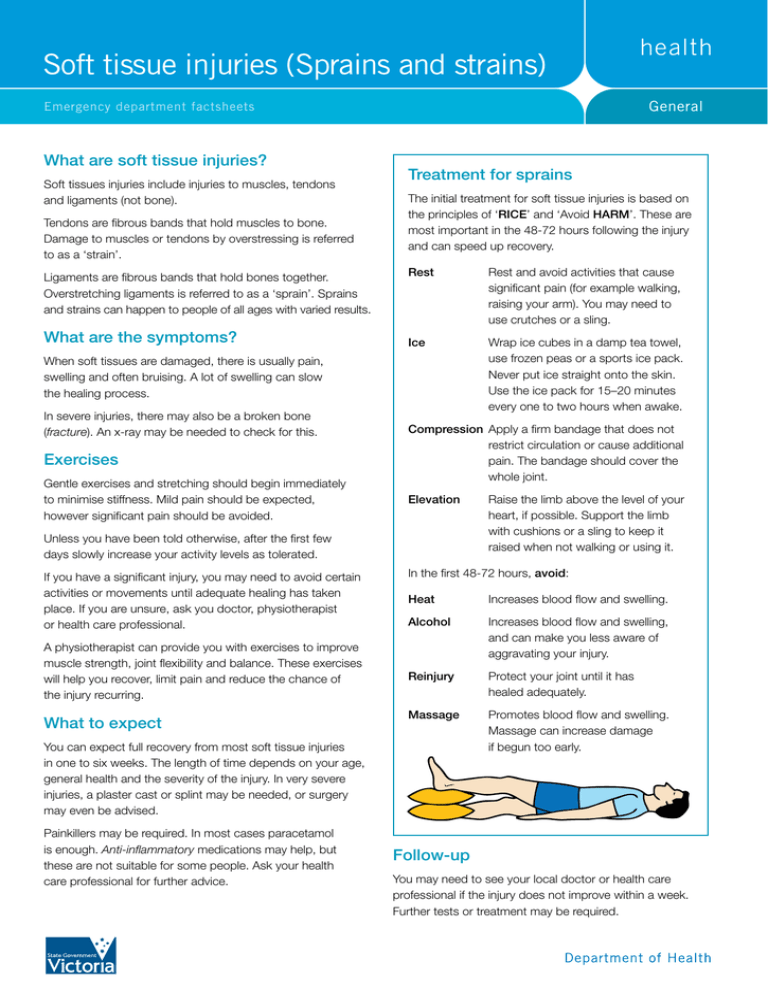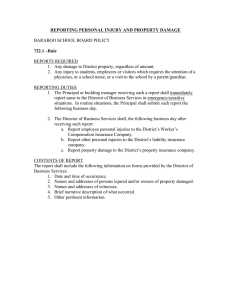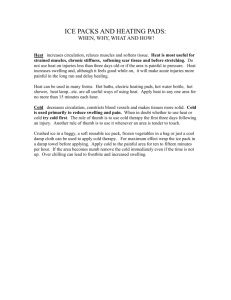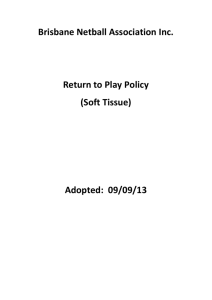Soft tissue injuries (Sprains and strains)
advertisement

Soft tissue injuries (Sprains and strains) General Emergency department factsheets What are soft tissue injuries? Soft tissues injuries include injuries to muscles, tendons and ligaments (not bone). Tendons are fibrous bands that hold muscles to bone. Damage to muscles or tendons by overstressing is referred to as a ‘strain’. Ligaments are fibrous bands that hold bones together. Overstretching ligaments is referred to as a ‘sprain’. Sprains and strains can happen to people of all ages with varied results. What are the symptoms? Treatment for sprains The initial treatment for soft tissue injuries is based on the principles of ‘RICE’ and ‘Avoid HARM’. These are most important in the 48-72 hours following the injury and can speed up recovery. Rest Rest and avoid activities that cause significant pain (for example walking, raising your arm). You may need to use crutches or a sling. Ice Wrap ice cubes in a damp tea towel, use frozen peas or a sports ice pack. Never put ice straight onto the skin. Use the ice pack for 15–20 minutes every one to two hours when awake. When soft tissues are damaged, there is usually pain, swelling and often bruising. A lot of swelling can slow the healing process. In severe injuries, there may also be a broken bone (fracture). An x-ray may be needed to check for this. Exercises Gentle exercises and stretching should begin immediately to minimise stiffness. Mild pain should be expected, however significant pain should be avoided. Compression Apply a firm bandage that does not restrict circulation or cause additional pain. The bandage should cover the whole joint. Elevation Unless you have been told otherwise, after the first few days slowly increase your activity levels as tolerated. If you have a significant injury, you may need to avoid certain activities or movements until adequate healing has taken place. If you are unsure, ask you doctor, physiotherapist or health care professional. A physiotherapist can provide you with exercises to improve muscle strength, joint flexibility and balance. These exercises will help you recover, limit pain and reduce the chance of the injury recurring. What to expect In the first 48-72 hours, avoid: Heat Increases blood flow and swelling. Alcohol Increases blood flow and swelling, and can make you less aware of aggravating your injury. Reinjury Protect your joint until it has healed adequately. Massage Promotes blood flow and swelling. Massage can increase damage if begun too early. You can expect full recovery from most soft tissue injuries in one to six weeks. The length of time depends on your age, general health and the severity of the injury. In very severe injuries, a plaster cast or splint may be needed, or surgery may even be advised. Painkillers may be required. In most cases paracetamol is enough. Anti-inflammatory medications may help, but these are not suitable for some people. Ask your health care professional for further advice. Raise the limb above the level of your heart, if possible. Support the limb with cushions or a sling to keep it raised when not walking or using it. Follow-up You may need to see your local doctor or health care professional if the injury does not improve within a week. Further tests or treatment may be required. Soft tissue injuries (Sprains and strains) General Emergency department factsheets Notes: Seeking help In a medical emergency go to the nearest hospital emergency department or call an ambulance (dial 000). For other medical problems see your local doctor or health care professional. For health advice from a Registered Nurse you can call NURSE-ON-CALL 24 hours a day on 1300 60 60 24 for the cost of a local call from anywhere in Victoria.* NURSE-ON-CALL provides access to interpreting services for callers not confident with English. Call 1300 60 60 24. *Calls from mobile calls may be charged at a higher rate Want to know more? • Ask your local doctor or health care professional. • Visit a physiotherapist • Visit the Better Health Channel www.betterhealth.vic.gov.au If you would like to receive this publication in an accessible format, please phone 9096 0578 or email edfactsheets@health.vic.gov.au December 2010. Also available online at www.health.vic.gov.au/edfactsheets Disclaimer: This health information is for general education purposes only. Please consult with your doctor or other health professional to make sure this information is right for you. Authorised by the Victorian Government Melbourne (1009025)



